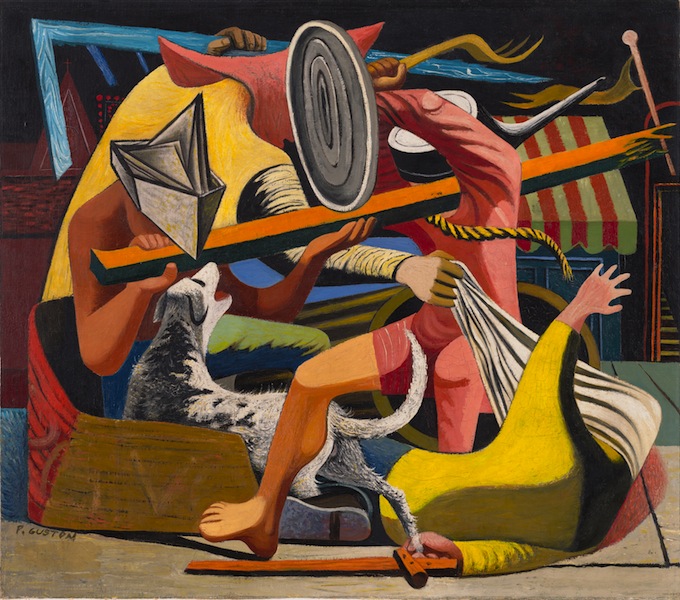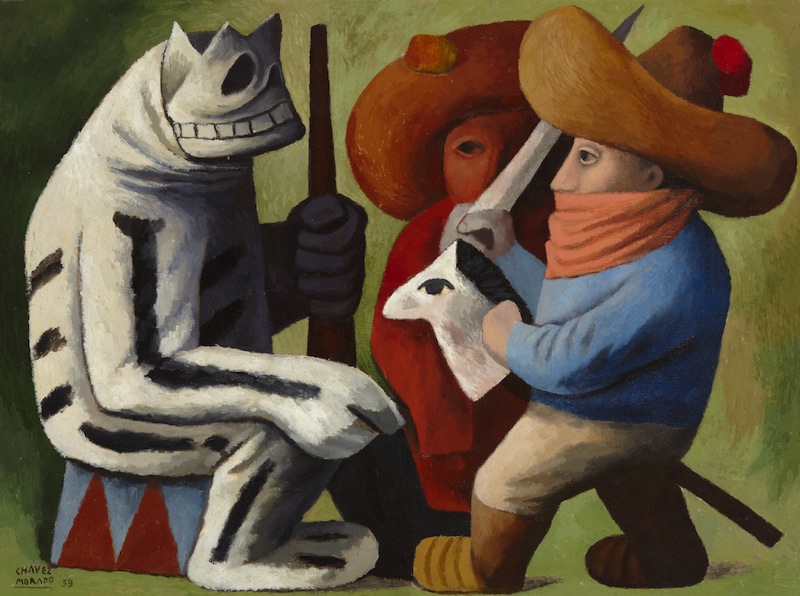Artists love a good revolution. The social upheaval, the bubbling up of new ideas and the breaking down of old ones, attracts them like flies to fly paper. The Mexican revolution was no exception. During the years 1910-1940, Mexico attracted large numbers of international intellectuals and artists, seduced by the political maelstrom and apparent freedoms that beckoned in this culturally diverse and varied land.
For many European artists Mexico seemed like a primitive (if somewhat fictional) Nirvana, with its stunning scenery, indigenous culture and mysticism that fed the modernist appetite for authenticity and new experiences. Anyone who was anyone wanted to be part of the action. Josef Albers, Edward Burra, Philip Guston (pictured below right: Gladiators, 1940; Museum of Modern Art, New York), and the photographers Cartier-Bresson, Tina Modotti, Edward Weston and Paul Strand, along with writers such as Somerset Maugham and D. H. Lawrence, all came to feed at this table of violence and exotic otherness, alongside native Mexican born artists, in an unabashed display of cultural appropriation. “How beautiful the revolution is, even in its savagery,” chirped the Mexican writer, Mariano Azuela.
Many fine photographs reveal the extent of death and destruction that beset the country
The beginning of the 20th century was an era of political ferment. The Russian Revolution and the Spanish Civil War saw the rise of the masses against the privileged few. The 1910 outbreak of the Mexican Revolution brought to an end the 26-year reign of Porfirio Diaz, known as the "Porfiriato", during which a small landowning class dominated the country both economically and politically, living a luxurious lifestyle that imitated the Belle Époque in France and the East Coast of the United States. That year Halley’s Comet was clearly visible in the Mexican skies. Taken as an auspicious sign, it was later seen, as it had been in 1517 by the Mexica (Aztecs) with the arrival of Hernán Cortés and his plundering Spanish conquistadores, as a portent of violent change.
Mexico: A Revolution in Art, 1910-1940 examines how the Revolution shaped not only contemporary Mexico but brought it in from the cultural peripheries to place it centre-stage within the modernist debate.
 The Mexican Revolution was, in fact, many things. Brutal and fragmented, it nonetheless brought about an artistic renaissance within the country. This was largely made possible by the technical advances in film and photography that allowed the disasters of war to be laid bare in visceral-style of reportage. That the Revolution received more news coverage than any conflict before the Second World War was, no doubt, in part due to the fear of invasion from the neighbouring Americans, who displayed an insatiable, and perhaps anxious, appetite for news. The "most famous bandit-rebel of the Revolution", Francisco "Pancho" Villa - with his cartoon sombrero, bullet belts and Zapata moustache - even struck a highly advantageous financial deal with the Mutual Film Corporation to fight battles during the day, so that they could be caught on camera.
The Mexican Revolution was, in fact, many things. Brutal and fragmented, it nonetheless brought about an artistic renaissance within the country. This was largely made possible by the technical advances in film and photography that allowed the disasters of war to be laid bare in visceral-style of reportage. That the Revolution received more news coverage than any conflict before the Second World War was, no doubt, in part due to the fear of invasion from the neighbouring Americans, who displayed an insatiable, and perhaps anxious, appetite for news. The "most famous bandit-rebel of the Revolution", Francisco "Pancho" Villa - with his cartoon sombrero, bullet belts and Zapata moustache - even struck a highly advantageous financial deal with the Mutual Film Corporation to fight battles during the day, so that they could be caught on camera.
This exhibition has many fine photographs that reveal the extent of death and destruction that beset the country. The newspaper office in Mexico City, a banner declaring El Heraldo Independiente draped across the peppering of bullet holes and broken windows and the smashed apartments of the rich with their shattered chandeliers, captured in sepia-tones by Manuel Ramos, show the wide-ranging damage.
 Although the Revolution’s aspirations may have originally been idealistic, the day-to -day reality was very different. Summary executions by hanging and firing squad and piles of battle-dead were recorded by the American Walter Horne. Seeing the chance of a business opportunity, he was to establish the Mexican War Photo Postcard Company for those hungry to see events first hand. Meanwhile, the iconic (and posed) photograph of the notorious Emiliano Zapata, by the German-born Hugo Brehme, was turned into an engraving by José Guadalupe Posada to illustrate cheap broadsheets for the mass market. Pofriro Diaz hadn’t much liked photography. It was too real and too gritty and he had insisted only on images that showed the Mexican people in a positive light. But for the revolutionaries photography was a way to show the world what they were suffering. (Pictured above left: Jose Chavez Morado, Carnival in Huejotzingo, 1939; Phoenix Art Museum.)
Although the Revolution’s aspirations may have originally been idealistic, the day-to -day reality was very different. Summary executions by hanging and firing squad and piles of battle-dead were recorded by the American Walter Horne. Seeing the chance of a business opportunity, he was to establish the Mexican War Photo Postcard Company for those hungry to see events first hand. Meanwhile, the iconic (and posed) photograph of the notorious Emiliano Zapata, by the German-born Hugo Brehme, was turned into an engraving by José Guadalupe Posada to illustrate cheap broadsheets for the mass market. Pofriro Diaz hadn’t much liked photography. It was too real and too gritty and he had insisted only on images that showed the Mexican people in a positive light. But for the revolutionaries photography was a way to show the world what they were suffering. (Pictured above left: Jose Chavez Morado, Carnival in Huejotzingo, 1939; Phoenix Art Museum.)
Most Mexicans were illiterate and the Catholic Church had traditionally used murals as an educative tool. The newly formed revolutionary government needed ways to promote their ideals and took a leaf from Church’s book and in 1920 sent Diego Rivera to look at Italian frescos. On his return he was commissioned to paint murals that told the story of Mexico through the eyes of its indigenous people. This did much to reinstate the mural as a valid modernist form. Rivera, José Clemente Orozco, along with his rival, the painter David Alfaro Siqueiros were to became known as los tres grandes, though their brand of proselytizing public works were not to everyone’s taste. It's interesting that in these less politically committed, more narcissistic, times their names have been somewhat eclipsed by the solipsistic works of Diego’s wife, Frida Kahlo, so it’s strange that she is so under represented here, with only one miniature self-portrait.
The years between 1910-1940 were extraordinary times, attracting extraordinary people from around the world, from Leon Tolstoy to André Breton, from Graham Green to Evelyn Waugh, each seeking his or her own "version" of Mexico. It is hard to imagine a war ever having that cultural pull again. But this unique matrix of indigenous and European, modern, pre-Columbian and Catholic art was, as this incisive exhibition shows, to have a lasting impact on the imagery of the 20th century.
- Mexico: A Revolution in Art 1910-40 at the Royal Academy from 6 July until 29 September









![SEX MONEY RACE RELIGION [2016] by Gilbert and George. Installation shot of Gilbert & George 21ST CENTURY PICTURES Hayward Gallery](/sites/default/files/styles/thumbnail_125_x_125_/public/mastimages/Gilbert%20%26%20George_%2021ST%20CENTURY%20PICTURES.%20SEX%20MONEY%20RACE%20RELIGION%20%5B2016%5D.%20Photo_%20Mark%20Blower.%20Courtesy%20of%20the%20Gilbert%20%26%20George%20and%20the%20Hayward%20Gallery._0.jpg?itok=3oW-Y84i)





Add comment